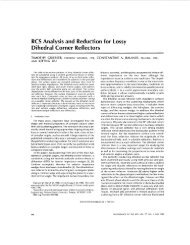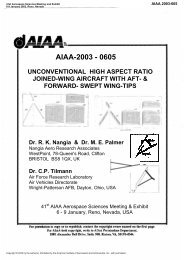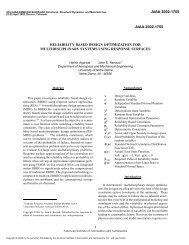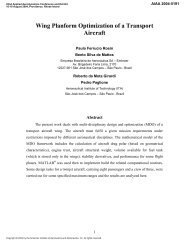Application of MDO to Large Subsonic Transport Aircraft
Application of MDO to Large Subsonic Transport Aircraft
Application of MDO to Large Subsonic Transport Aircraft
You also want an ePaper? Increase the reach of your titles
YUMPU automatically turns print PDFs into web optimized ePapers that Google loves.
(c)2000 American Institute <strong>of</strong> Aeronautics & Astronautics or published with permission <strong>of</strong> author(s) and/or author(s)’ sponsoring organization.<br />
Alexander Van der Velden<br />
Roland Kelm<br />
David Kokan<br />
Josef Mertens<br />
AMA-2000-0844<br />
<strong>Application</strong> <strong>of</strong> MD0 <strong>to</strong> <strong>Large</strong> <strong>Subsonic</strong><br />
<strong>Transport</strong> <strong>Aircraft</strong><br />
Synaps, Inc., velden@synaps-inc.com<br />
president-<br />
Daimler-Chrysler Aerospace Airbus, Hamburg, Germany<br />
head aeroelastic structures<br />
Synaps, Inc.<br />
senior consultant<br />
Daimler-Chrysler Aerospace Airbus, Bremen, Germany<br />
RAWID project manager aerophysics division<br />
Daimler-Chrysler Aerospace Airbus and Synaps developed a preliminary design <strong>to</strong>ol <strong>to</strong> quickly trade-<strong>of</strong>f wing<br />
planform, thickness and lift distribution on a large commercial passenger transport wing. Goal <strong>of</strong> this study was <strong>to</strong><br />
minimize the weight <strong>of</strong> the wing structure + fuel at a constant maximum take<strong>of</strong>f weight. The design study was<br />
performed with the PointerTM MD0 framework s<strong>of</strong>tware. Pointerm couples the required analysis codes and<br />
searched the design space for the best solution. The section drag was determined using a large database <strong>of</strong> swept<br />
airfoils that were shape optimized for specific design conditions. The wing loads and induced drag were<br />
determined with a vortex-lattice code. The weight <strong>of</strong> the wing was estimated using the Airbus FAME s<strong>of</strong>tware<br />
which sizes the wing primary and secondary structure based on the wing loads with static aero-elastic effects. The<br />
present method used led <strong>to</strong> significant performance improvements (which were confirmed by later detailed<br />
studies) and a better understanding <strong>of</strong> what drives the design <strong>of</strong> very large transports. As compared <strong>to</strong><br />
conventional design iterations performed by teams <strong>of</strong> experts, the present method requires only half the time per<br />
design cycle and a fraction <strong>of</strong> the number <strong>of</strong> design cycles <strong>to</strong> converge the design.<br />
Introduction<br />
The design <strong>of</strong> a new very large transport [Fig. 1,<br />
Ref. 131 poses several challenges <strong>to</strong> the<br />
conventional method. In the conventional<br />
approach, the preliminary design department<br />
proposes an initial description <strong>of</strong> the design <strong>to</strong><br />
the aerodynamic design team. This team finishes<br />
a full aerodynamic design optimization for this<br />
configuration and then passes this detailed<br />
geometry <strong>to</strong> the structural design group who<br />
compute the required weights. However, in the<br />
case <strong>of</strong> very large aircraft, many detailed design<br />
cycle iterations (>lO) were required <strong>to</strong> converge<br />
<strong>to</strong> an optimal design. One <strong>of</strong> the reasons for that<br />
is because the initial preliminary design does not<br />
include the right level <strong>of</strong> physical modeling <strong>to</strong><br />
trade-<strong>of</strong>f design decisions for a very large<br />
transonic aircraft.<br />
1<br />
American Institute for Aeronautics and Astronautics<br />
Fig 1: Proposal for a new large aircraft<br />
(pho<strong>to</strong> Airbus industrie)<br />
This problem is the most pressing for wing<br />
design. Therefore, in the past 6 years significant<br />
effort has been invested <strong>to</strong> create preliminary<br />
design <strong>to</strong>ols that accurately predict the<br />
aerodynamic and structural potential <strong>of</strong> well<br />
designed transonic aircraft wings. With these


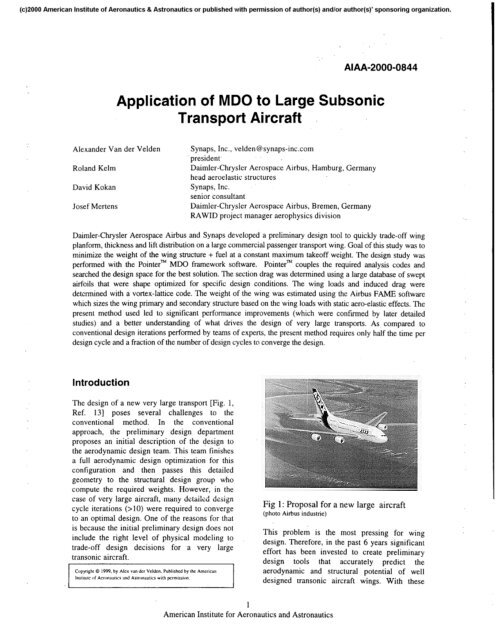





![Introduction to RF Stealth [Book Review] - Antennas and ...](https://img.yumpu.com/16857890/1/190x245/introduction-to-rf-stealth-book-review-antennas-and-.jpg?quality=85)

